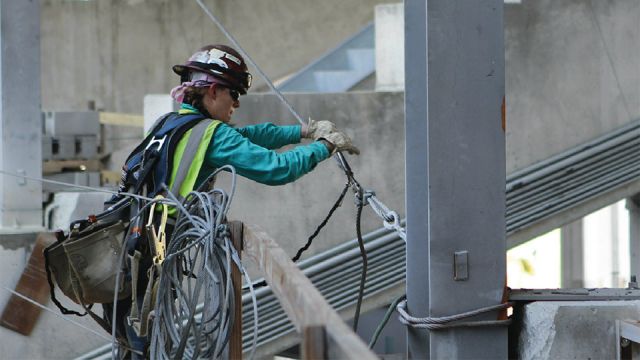Taking training to new heights
Attracting millennials to the construction industry
Historically, we have seen eras of revolution, innovation and information. Now we have come into the era of human potential. This idea that has been presented and expounded upon by ManpowerGroup, a global workforce solutions firm, speaks directly to the human spirit in us all. It has positive connotations and gives hope to many who feared technology would replace skilled professionals. However, as positive as this may sound, the problem is that as a nation, we became complacent. As we moved toward technology being the wave of the future, we moved away from teaching younger generations to use their minds and hands to actually build things. We failed to provide many of them with the skills they need to succeed in this new era. As a result, we, as a nation, find ourselves in a period of vast skilled workforce shortages.
Clarification of the Shortage
The recent skilled workforce shortage numbers in the construction industry have been eye opening and met with skepticism by some outside the industry. People have questioned whether there could be such a vast workforce shortage if wages have not significantly increased within the construction industry, reflecting such a demand. The answer is yes. First, signs of recession or recovery are slower to materialize in the industrial and commercial construction sectors. Although the construction sector is driven by economic trends, it is a lagging industry with construction volumes typically surfacing in later periods. This lag may be one of the reasons why there has not been overall significant wage increases in the industry. However, according to Alpha Resources, signs of recovery are beginning to surface, and we are starting to see wages escalate and per diem become more readily available. There is still some uncertainty within the American economy as a whole, and contractors are hesitant to move forward with spending the necessary money to secure a qualified workforce and do the training necessary to staff projects.It is important to point out that there have been documented increases in wages for certain “in-demand” crafts. NCCER conducts an informal annual Craft Wage Survey amongst industrial and commercial sector executives. The 2013 survey shows an increase in pay in 76 percent of the crafts surveyed from the 2012 results with welder, industrial maintenance mechanic, heavy equipment operator, electrician and instrumentation technician having the largest wage increases.
Also, there are other incentives that need to be looked at in addition to wages. Bloomberg Businessweek recently reported that companies are “sweetening benefits packages” and getting creative in their incentives to draw in qualified skilled professionals. Gourmet dining and retention bonuses are just a few creative options that are mentioned in the April 17 article. Contractors are starting to feel the crunch and are looking for ways to attract talent.
The Construction Labor Market Analyzer (CLMA) reports that the nation’s nonresidential construction labor force currently stands at 5 million workers, which is a decrease of 1 million prior to the Great Recession. It also predicts that 600,000 more workers will be needed by the end of 2014 and rising to 7 million by 2018. These numbers are calculated based on CLMA’s five-year pipeline of project starts, which totals $2.3 trillion. Most of this anticipated growth is within a thirteen-state region of the South. These areas are already feeling the squeeze with more than half of the thirteen states experiencing below average unemployment rates. According to the Bureau of Labor Statistics April 2014 report, the national unemployment average is 6.3 percent, with Louisiana, Oklahoma and Virginia below five percent and Texas and South Carolina below six percent.
To further solidify the expansion of the construction industry, the Associated General Contractors (AGC) reported that the unemployment rate in construction dropped to the lowest level in seven years for the month of April as 32,000 workers were added to the industry. In fact, nonresidential construction – building, specialty trades and heavy and civil engineering grew by more than 81,000 workers since April 2013, according to AGC.
A Strategic Internal Evaluation
For years, young people followed their parents and grandparents into a particular craft and learned many of their skills directly from their family member or by entering a training program. Much to the dismay of the construction industry and other skill-oriented professions, this natural pipeline of young new recruits dried up quite some time ago. This has led many industries to look for new channels to feed their ever-growing need for people interested in learning a skilled profession. To worsen the problem, industries are all vying for the attention and interest of the same groups. Construction is competing with aerospace, health care, hospitality and manufacturing to name a few. In order to compete with these other sectors, the construction industry must look internally to make sure it has structured itself as an appealing sector that is interested in recruiting and developing a new generation of craft professionals. The industry also needs to choose the most appropriate recruitment initiatives to ensure individuals choose construction.Mark Perna, the founder of Tools for Schools, recently spoke at the Associated Builders and Contractor’s annual Workforce Development Conference. He talked about how millennials, the 14 to 35 age demographic, need to feel part of a group and look for coaches and mentors instead of bosses. Like it or not, agree or disagree, in order for the construction industry to compete for new recruits, it must understand what makes this generation tick. Interesting enough, this idea of mentorship is exactly how the construction industry started and is a good place for the industry to return in order to appeal to this generation.
Tapping into existing talent is the first step to developing a program that will grow a company’s skilled workforce. Evaluating its current workforce is vital in identifying key craft professionals that can mentor and train the next generation of qualified professionals. Retaining those key individuals through recognition of their skills and then asking them to pass along their knowledge can go a long way. Manpower Group’s report, Break the Crisis and Complacency Cycle, supports this by stating, “To thrive and grow, companies and governments will need to engage and motivate older workers to remain in the workforce longer, and find a way to engage and train their youth, particularly by aligning training and education systems with the skills required by employers.”
With the age of human potential upon us, it is the individuals who begin to take precedent over other factors. Production, information and technology are all dependent upon having a workforce that has the skills to understand what to do and why. Carl Peters, director of training for The Lincoln Electric Company, stated that we not only have a skills gap, but we also have a knowledge gap. He added that a 50-year-old welder not only knows how to weld a solid bead, but he knows why it is needed in each situation. Peters said it is that knowledge that needs to be passed on to the next generation.
Continuing with this internal evaluation, contractors have to move away from the belief that investing in training a worker will only benefit the next contractor who employs that individual. Individuals with skills, or the desire to learn skills, are naturally looking for an organization or company that will offer the best skill and career development. Perna states that millennials are looking for experience and training that is relevant to their future. They need to connect the dots with what they are learning and doing today with a successful future. Therefore, established skills progression programs that pay workers for skills attainment along with solid benefits packages, good working conditions and a positive company culture are more important than ever if construction is to attract this generation. It is not about changing the image of the construction industry, it is about actually making sure the industry is structured in such a way that it is an appealing choice for this generation.
Recruiting the Next Generation
The next step is to identify opportunities for recruitment. There are many popular recruitment channels available, but the industry will need to broaden its search, prepare for current and future needs and become actively involved in comprehensive recruitment and training plans. Outreach in the form of advertising materials is not enough.The most recognizable recruitment channels are Career and Technical Education (CTE) programs, transitioning military programs, contractor associations and community and career colleges. These areas are all important, but they alone cannot fulfill the current and future demand. Other areas to consider are youth development organizations like SkillsUSA, Boy Scouts, Girl Scouts and Future Farmers of America (FFA). Youth programs and minority organizations like YouthBuild and Job Corps are often overlooked but offer opportunities for contractors to find young people who are looking for rewarding career opportunities. Peters speaks passionately about the 300 Boy Scout councils that are looking for help and the 550,000 students in FFA programs across America. He said that companies need to start their searches and recruitment activities with their local organizations.
Only 26 percent of high school students and 64 percent of postsecondary students who take craft training while in school enter the construction industry. This can be partially contributed to the lack of collaboration between industry and education. Many students and parents assume that construction means homebuilding and are therefore unaware of the numerous opportunities available in the commercial and industrial sectors. On the industry side, the complaint is that schools are not teaching the specific skills contractors are looking for in new recruits. Given these facts, the solution seems to be obvious: the industry must increase its support for CTE programs and work closely with education providers to ensure these programs are teaching students the skills to succeed on the project site. Secondary and post-secondary education needs to look to industry to sit on their advisory boards and participate in the development and sustainability of their construction CTE programs.
Industry must actively participate in the training these individuals receive before they are hired. In conjunction with this, educators must listen to the organizations that are going to hire and continue training their students. When choosing a curriculum or creating a program, schools and CTE teachers need to focus on where their students are going when they leave their programs. It is not enough to select a program they are familiar with. The program needs to lead to industry recognition and acceptance. The educators who understand this strategic vision are the ones who will succeed. And the construction organizations that help them are the ones that will reap the benefits of better trained employees.
Successful Industry and Education Partnerships
LPR Construction of Loveland, Colo., exemplified an effective industry and education collaboration when it reached out to the local community college to kick-start an Ironworking/ Welding program. The community college needed a pipeline of new recruits due to budget cuts in their CTE programs, so they were receptive to working with LPR. The program, which is also open to local high school students, has been very successful. Each year, the program’s 100-hour ironworker class is taught to 25 – 30 apprentices who do not have industry experience, and typically five to seven of those students go on to become LPR employees. Bryan McClure, LPR’s senior training manager, gives this advice to construction companies wanting to get involved with their local schools, “Be persistent and very patient when dealing with school systems. The schools and state institutions do not operate with the same sense of urgency as the private sector.”Providing career pathways and industry-recognized credentials to students has greatly benefitted LPR. Due to their outreach and development of continuing education programs, LPR has seen both the quality of their employees and their retention rates increase. This focused training and support has led to a decrease in job-site injuries and an increase in on-time project completions. LPR feels that its safety practices play a major role in recruiting and retaining. In fact, LPR held a class for their general foremen and directly asked what kept them at LPR, and the overwhelming answer was a strong safety program.
Gaylor Electric, based out of Indianapolis, is another great example of industry reaching out to education and finding success. Chuck Goodrich, executive vice president of Gaylor, is very passionate about the summer internships they have set up with local secondary and post-secondary schools. They currently have 70 interns enrolled, of which 50 are from college programs and 20 are from high school. Gaylor has become actively involved with Noblesville High School and hired the school’s at-risk coordinator to be their intern coordinator for the summer to ensure the interns are getting the most out of the program.
Gaylor also works directly with Noblesville High School and community leaders to overcome age obstacles so interns can gain experience on project sites. The partnership has taken school involvement to a new level by bringing students in during the school year for tours and inviting all area high school counselors to visit their company and learn about the numerous employment opportunities in construction. The counselors tour human resources, accounting, engineering, IT and the warehouse. They also participate in hands-on electrical and HVAC activities.
Goodrich is proud about how Gaylor has partnered with other industries like health care and hospitality during the tours, allowing students and educators to see all of the opportunities in skilled professions. Beth Meguschar and Susan Wiersema from Noblesville High School have worked closely with Goodrich and have been impressed with the commitment Gaylor has made to their school. Meguschar and Wiersema have led the charge on the education side and have been proactive in providing NCCER Curriculum and credentials to their students. “Together we can produce more,” said Goodrich. He challenges other contractors to join Gaylor in reaching out to local schools and providing an industry connection.
A great example from the education perspective of this industry and education collaboration is the North Carolina Department of Public Instruction (NCDPI). In this case, NCDPI sought out a way to offer industryrecognized credentials in their CTE programs and approached a local construction contractor association. The Carolinas AGC chapter suggested offering NCCER’s industry-recognized credentials and became the school system’s Accredited Training Sponsor. Eventually the program grew, and after speaking with industry stakeholders, NCDPI became the NCCER-accredited body for the state education program. During the 2008-2009 school year, the State Board of Education officially adopted the NCCER curriculum for three craft areas.
The program has since increased to include 10 craft areas and more than 600 NCCER certified instructors teaching in the CTE division. More impressive is the fact that in the past three years alone, more than 13,500 students have earned NCCER credentials. The program’s success has been highlighted in the positive high school graduation rate – in 2012, 94 percent of all North Carolina students enrolled in a CTE program graduated high school, compared to 80 percent of traditional students.
One of the key elements to the success of these programs comes from NCDPI’s efforts to stay connected with their industry partners. In 2009, the NCDPI strengthened their program by reaching out to various industry associations and forming official partnerships. Craig Pendergraft, who is NCDPI’s education consultant and is in charge of student certification and credentialing for the state’s CTE programs, credits the success of the construction education program to, “the relationships that existed and continue to grow between all of our partners and the NCDPI consultants.” The partners come together with local contractors and suppliers to support high schools by serving on advisory committees and providing guidance. They also arrange field trips, provide materials and supplies, serve as guest speakers and chair the SkillsUSA® regional and state competitions.
For large organizations, like school districts, that want to launch an industry-recognized credentialing program like NCCER, Pendergraft suggests gathering support from associations and contractors who already use the NCCER process. He also encourages other sponsor representatives to educate their local workforce development agencies, community colleges and industry organizations that are not familiar with NCCER. This provides support for the NCCER process from the top down. Taking ownership through accreditation for an entire school system gives a strong foundation for education and industry partnerships.
Industry education connections like these need to be duplicated across the country if we are going to meet the needs of our industry. We need to stop talking and start doing. We need to get out of the box we have been in as an industry and realize that even if we do all of this, we must begin to establish our pipeline of recruits at a much younger age. Research conducted by software giant Microsoft finds that students decide what subjects they like and dislike by the fifth grade. With this in mind, an interesting point that industry representatives interviewed for this article made was that the construction industry must do a better job of reaching out to middle and elementary schools. The industry must broaden its focus in connecting with education and realize that shaping its image and building a pipeline of skilled professionals actually begins before high school.
Moving Forward
The age of human potential is upon us, and it is our job to take full advantage of what millennials have to offer the industry. Despite the skilled workforce shortage that exists, there is an entire generation of young people who are available to fill the void. With the proper recruitment and image enhancement practices, the construction industry has the ability to attract, train and hire millenniaIs, but it can't accomplish this alone. Industry and education need to work together to improve the image and integrity of skilled professions. Training and education need to align more dosely to meet industry and real-world needs, and the industry must partner with CTE educators and other youth development programs to ensure that classroom regimens are accomplishing this. This collaboration will allow individuals to develop relevant skills and immediately contribute to the workforce.Suzanne Deremo, director of human resources at LPR, adds, “If recruiting was as simple as placing an advertisement, we would have the problem solved.”
About the Author
Jennifer Wilkerson is the Director of Marketing for NCCER.
This article was originally published in the Spring/Summer 2014 edition of NCCER’s The Cornerstone magazine (www.nccercornerstone.org/digital). This content has been republished with the permission of NCCER and the publisher.



















